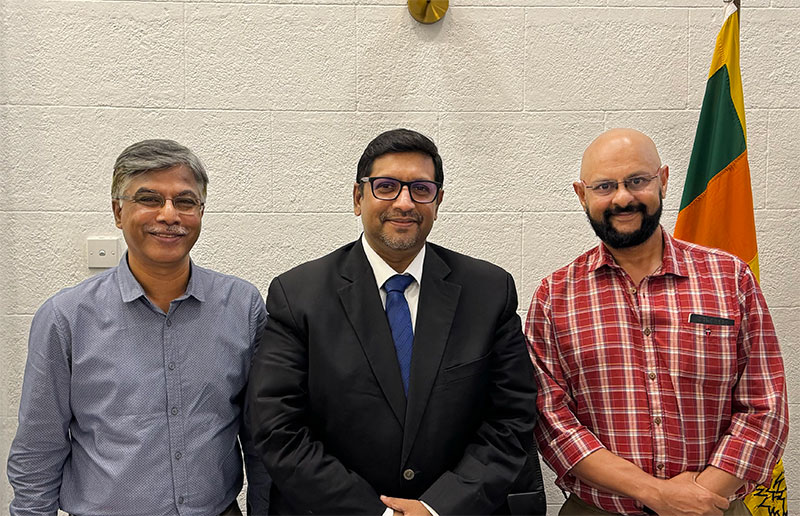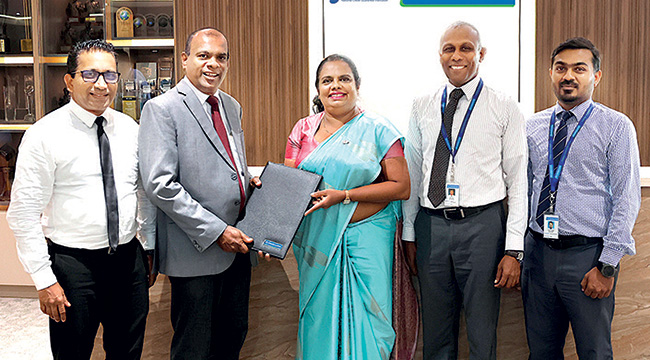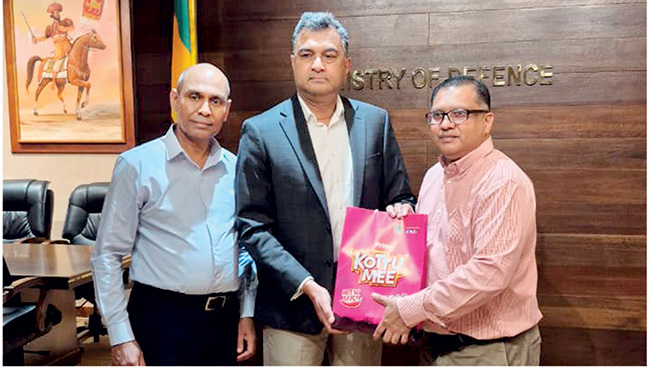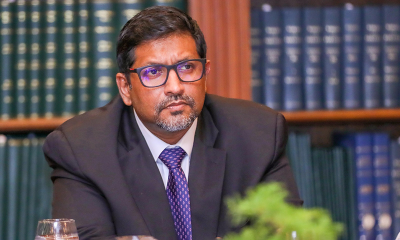Business
Sri Lanka to focus on Green Entrepreneurship

The United Nations has recently applauded Sri Lanka’s efforts to restore and expand the island’s mangrove cover by over 50 percent. The country has been selected as one of the seven UN World Restoration Flagships for its pioneering efforts in mangrove restoration.
Senior Advisor to the President on Climate Change, Ruwan Wijewardene, is actively preparing for the next phase of efforts in this direction. A meeting was held with Ravi Pratap Singh, Managing Director of iLEAD International Academy, Sri Lanka, which has come up with a comprehensive plan to promote Green Entrepreneurship in the country and develop mangroves with the involvement of youth. Green entrepreneurship, the plan suggests, would create a sustainable mechanism for maintenance and growth of mangroves in the country.
The plan presented by Singh, along with CEO FCB KL.LK Santosh Menon, points out that at this stage, the acceleration in efforts to further expand the area under mangroves would require re-introduction of a more systematic and scientific community-led effort to plant mangroves in the country to ensure greater survival rates. A large number of youths in the coastal areas of the country- looking for livelihood options, could be developed as Green Entrepreneurs to take this effort forward. This would help Sri Lanka to continue claiming the global leadership in its efforts towards ecosystem protection, restoration and growth and show the way to the entire world.
Considering the fact that the last mile efforts are always tough, the comprehensive plan envisages new energise through an attractive proposition of youth entrepreneurship and their sustained engagement in this direction. Wijewardene appreciated the fact that this plan not just considers promotion of some of the established enterprises around mangrove-based products like mangrove honey and resins, but it also explores the latest innovations to promote entrepreneurship in bio-mimicry based products like ECOncrete; and co-existence-based products and services where mangroves are developed along with shrimp farming.
The plan includes role of all strategic players to ensure success. Government would like to see involvement of coastal communities at the core of it, supported by the scientific and business communities. The iLEAD International Academy, a social business initiative in the country, with successful mobilisation of more than 12,500 youth for vocation training and entrepreneurship development, aims to mobilise 6,500 youth spread across 64 DS Divisions of the country with maritime border to be the Green Entrepreneurs under this plan.
During the initial discussions with Thushira Radella and Mr. Dan de Silva of Chamber of Young Lankan Entrepreneurs (COYLE), with Dr. Rupesh Bhomia of the Centre for International Forestry Research and International Centre for Research in Agroforestry (CIFOR-ICRAF) based in Colombo, and with Kapila Dhanapala, Country Manager of Aide et Action International, they have expressed their keen interest and willingness to be the significant collaborators of this plan.
UN Decade on Ecosystem Restoration (2021-2030), led by UNEP and FAO, monitors the UN World Restoration Flagships. It has projected the need to create 4000 Green Jobs to restore 10,000 hectares of mangroves in Sri Lanka by 2030. This according to them would require US$3.5 million, i.e., approximately Rs. 1,050 million.
It is proposed in the plan that many corporates outside Sri Lanka, looking for carbon/green credit have been contacted and they would be tapped to mobilise resources for this work.
The office of Ruwan Wijewardene has proposed a meeting of selected key stakeholders towards the end of April 2024, to give a concrete shape to this plan. He also said that the government of Sri Lanka would quickly work towards developing a policy for carbon/green credit certification in the country to attract more resources from outside the country for this purpose.
Business
HNB Finance bags 2 CMA Reporting Awards 2025

HNB Finance PLC has been honoured with two prestigious accolades at the CMA Excellence in Integrated Reporting Awards 2025, reaffirming the company’s commitment to transparency, good governance, and integrated business performance.
At this year’s ceremony, HNB Finance PLC was awarded Second Runner Up – joint in the category of “Best Integrated Report , Finance and Leasing Sector”, and also received a Merit Award in recognition of its continued efforts to enhance reporting quality and strengthen stakeholder communication.
The CMA Excellence in Integrated Reporting Awards, organised annually by the Institute of Certified Management Accountants (CMA) of Sri Lanka, acknowledge organisations that demonstrate superior financial reporting standards aligned with global best practices. Winners are assessed on key criteria such as financial performance and strategic management, corporate governance and compliance, innovation and digital transformation, sustainability practices, and professional excellence.
Chaminda Prabhath, Managing Director/CEO of HNB Finance PLC, commented on the recognition, “These awards reaffirm our commitment to upholding the highest standards of integrated reporting and transparent financial disclosure. At HNB Finance, we remain focused on delivering sustainable long-term value through robust governance frameworks, prudent financial management, and continuous innovation. The acknowledgement by CMA Sri Lanka reflects the disciplined efforts of our teams across the organization and motivates us to further enhance our reporting quality, strengthen ESG integration, and reinforce our stakeholder centric approach.”
Business
ComBank joins ‘Liya Shakthi’ scheme to further empower women-led enterprises

The Commercial Bank of Ceylon has reaffirmed its long-standing commitment to advancing women’s empowerment and financial inclusion, by partnering with the National Credit Guarantee Institution Limited (NCGIL) as a Participating Shareholder Institution (PSI) in the newly introduced ‘Liya Shakthi’ credit guarantee scheme, designed to support women-led enterprises across Sri Lanka.
The operational launch of the scheme was marked by the handover of the first loan registration at Commercial Bank’s Head Office recently, symbolising a key step in broadening access to finance for women entrepreneurs.
Representing Commercial Bank at the event were Mithila Shyamini, Assistant General Manager – Personal Banking, Malika De Silva, Senior Manager – Development Credit Department, and Chathura Dilshan, Executive Officer of the Department. The National Credit Guarantee Institution was represented by Jude Fernando, Chief Executive Officer, and Eranjana Chandradasa, Manager-Guarantee Administration.
‘Liya Shakthi’ is a credit guarantee product introduced by the NCGIL to facilitate greater access to financing for women-led Micro, Small, and Medium Enterprises (MSMEs) that possess viable business models and sound repayment capacity but lack adequate collateral to secure traditional bank loans. Through NCGIL’s credit guarantee mechanism, Commercial Bank will be able to extend credit to a wider segment of women entrepreneurs, furthering its mission to drive inclusive economic growth.
Business
Prima Group Sri Lanka supports national flood relief efforts with over Rs. 300 Mn in dry rations

Prima Group Sri Lanka has pledged assistance valued at over Rs. 300 million, providing essential Prima food products to support communities affected by the recent floods across the island. This relief initiative is being coordinated through the Ministry of Defence to ensure the timely and effective distribution of aid to impacted families.
As part of this commitment, Prima Group Sri Lanka donated a significant stock of Prima dry rations to the Government of Sri Lanka on 30 November. The consignment will be distributed across multiple severely impacted districts. These supplies will support families facing disruptions to daily life, ensuring they receive assistance as recovery efforts continue.
The handover took place at the Ministry, where the donation was received by the Secretary of Defence, Air Vice Marshal (Retired) Sampath Thuyacontha. Representing Prima Group Sri Lanka, Sajith Gunaratne – General Manager of Ceylon Agro Industries Limited, and Sanjeeva Perera – General Manager of Ceylon Grain Elevators PLC, officially presented the donation.
Prima Group has been standing with the people of Sri Lanka for over 40 years, and this donation reflects its broader commitment to the nation during challenging times. As relief operations continue across the island, the company remains focused on helping families rebuild their lives and supporting the ongoing recovery process in collaboration with the Government Authorities.
-
News4 days ago
Lunuwila tragedy not caused by those videoing Bell 212: SLAF
-

 News3 days ago
News3 days agoLevel III landslide early warning continue to be in force in the districts of Kandy, Kegalle, Kurunegala and Matale
-

 Latest News6 days ago
Latest News6 days agoLevel III landslide early warnings issued to the districts of Badulla, Kandy, Kegalle, Kurunegala, Matale and Nuwara-Eliya
-

 Features5 days ago
Features5 days agoDitwah: An unusual cyclone
-

 Latest News6 days ago
Latest News6 days agoUpdated Payment Instructions for Disaster Relief Contributions
-

 News1 day ago
News1 day agoCPC delegation meets JVP for talks on disaster response
-

 News1 day ago
News1 day agoA 6th Year Accolade: The Eternal Opulence of My Fair Lady
-

 Latest News7 days ago
Latest News7 days agoLandslide Early Warnings issued to the Districts of Badulla, Colombo, Gampaha, Kalutara, Kandy, Kegalle, Kurunegala, Matale, Moneragala, Nuwara Eliya and Ratnapura















